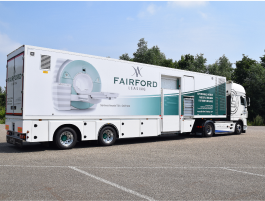When Sidsel Pedersen, a medical radiologic technologist (MRT) and instructor at the Southern Alberta Institute of Technology performed what she assumed to be a routine x-ray on an eight-year-old boy in 2017, she could not have foreseen a notable error she would make in the process. Upon completing the x-ray, she would soon discover some surprising news.
Despite the details listed in medical records, Pedersen learned that the patient actually identified as a female and preferred to be called ‘Harriet’ than Henry. While the x-ray was only of Harriet’s wrist, the experience inspired the MRT to consider ways in which traditional radiology practices discriminated against transgender patients. Although completely unintentional, the assumption of gender identity by healthcare professionals is a challenge faced by many transgender patients.
When exploring the subject further with fellow researchers, Pederson said that radiologists can often be confused due to unfamiliarity with specific preferences or needs. However, in order to ensure patients of all genders receive equal treatment and are not subject to discrimination, radiologists must work to better understand their transgender patients.
It starts with these five steps:
1. EDUCATE YOURSELF ON GENDER IDENTITY
A lack of understanding or awareness for the differences between gender identities and the preferred terms associated with them is usually the cause for unintentional discrimination of transgender or non-binary patients. In turn, individuals find themselves constantly explaining their mental state and their choices – a conversation that the majority of cisgender patients will never have to experience.
With a current spectrum of more than 20 known genders, it’s high time that radiologists familiarised themselves with the differences between transmale, transfemale, cisgender and non-binary identities and how gender expression and identity differ from biological sex or sexual orientation.
2. RECOGNISE THE STRUGGLES FACED BY THE TRANSGENDER POPULATION
Regrettably, discrimination is a fact of life for many transgender individuals. As well as having to justify their decisions and explain gender dysphoria to the uninformed, the transgender population on a whole still face an unbelievably high level of verbal, physical and sexual harassment. Many have even been dissuaded from using public toilets, so ensuring a safe environment in which all patients are treated with respect is paramount for radiologists and healthcare professionals.
3. NEVER ASSUME THE BIOLOGICAL SEX OF A PATIENT
While old habits die hard, radiologists must avoid relying on the medical ID of an individual to determine their biological sex. Since the transgender community is highly marginalised, “they feel unsafe every time they leave their houses,” according to Pederson, and it’s this behaviour can make a non-cisgender individual feel incredibly uncomfortable. In many cases, transgender individuals are required to wait at least a year before changing their gender on any identification documents: until then, sensitivity around the subject can help radiologists to show respect to their transgender patients, even if it’s a simple matter of double-checking the name they prefer to use.
4. CREATE A WELCOMING ENVIRONMENT
“Helping a transgender or non-binary patient feel comfortable and respected during an exam is no different from what we are already doing,” say Pederson and Sanders in their research. Ultimately, there will be certain unique physical considerations for transgender patients, but helping them to feel comfortable before an examination should not come as a new challenge.
As it stands, radiographers must adapt their approach to a wide range of patient personalities every day, taking into account any emotional challenges and anxieties. Ensuring all patients, no matter their gender, are made to feel comfortable should be second nature to professionals in this sphere.
5. CONSIDER USING SIGE FORMS
In their research, Pederson and Sanders proposed the idea of patients filling in forms prior to their examination; they put forward the notion that allowing the patient to state their own gender identity and name beforehand would remove the need for an awkward conversation after a mistake has already been made.
While no form currently exists, the one designed by the researchers asks for preferred name and preferred pronouns off the bat. Further to this, the patient is asked to identify where their reproductive organs are currently located, since ionizing radiation could be harmful to any reproductive organs that might still be in place. By asking every patient – regardless of their appearance – to complete sex, identity, gender and expression (SIGE) paperwork, physicians break down the barriers of bias and promote a comfortable environment for all individuals.











